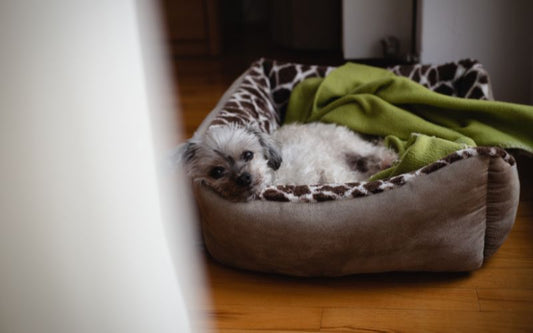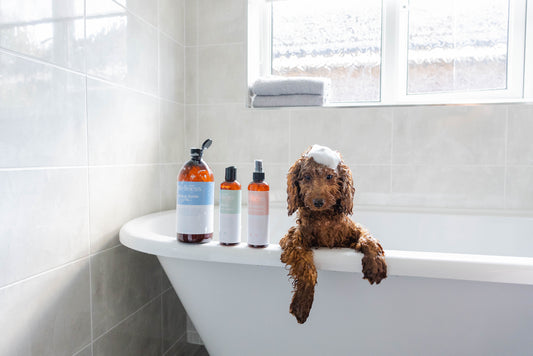Teaching your dog to walk nicely on a lead forms an important part of your dog's overall training. Since you will be walking with your dog everyday, you need to take time to help your pup learn this skill in a way that is positive and enjoyable.
Remember that walkies can be an extremely exciting time for dogs. It provides an opportunity for them to exercise, act playfully and take in new sights, sounds and smells. It's only natural for your dog to want to explore eagerly, so you shouldn't feel frustrated when they try to do so.
You want to strike the right balance between letting your dog walk comfortably beside you without taking control of the walk. So if you find your dog pulling on the lead to get ahead, loose lead walking exercises could help!
Many dog owners make the mistake of using correction methods that punish their dogs for pulling, but this is never the way to go. Instead, you can ensure lead training success at any age using rewards-based training. Keep reading to learn more:
- Why does my dog pull so much on the lead?
- Training a dog not to pull on the lead
- 5 steps to walking without lead pulling
- What to use for a dog that pulls
- What NOT to use for a dog that pulls
Why does my dog pull so much on the lead?
The reason that dogs naturally pull on their leads when out on walks is because they are excited to get where they are going. Dogs are curious animals which enjoy exploring their surroundings. To a dog, a lead is something that restricts them from moving at their natural pace, which is why walking on a lead is a behaviour that needs to be learnt over time.
If you find that your dog pulls during walks, it’s important to correct them straight away. This is because each time you let pulling happen, your dog will feel that this tactic is the correct way to move forward faster.
Don’t worry though, teaching your dog to walk on a lead correctly can be achieved at any stage in life. So whether you have a young puppy or an old dog, there's always room to teach it new tricks!
Training a dog not to pull on a lead:
Teaching your dog not to pull on the lead forms an important part of its overall training. As well as helping to keep your dog and the people around you safe, it also makes walks more enjoyable and encourages discipline.
Lead training requires time, effort and patience - so don't expect results overnight. Remember that this is not solely a learning experience for your dog, it's important for you to remain open-minded as you work with your dog.
Before you get started:
It's you who sets the tone for your dog's walk, so you must remove any pressure and expectations and go into lead training with a calm and positive mentality.
Your dog will look to you for guidance, so having a strong bond and foundation will naturally help to make the process easier. Remember that dogs are highly attuned to human emotion, so the more you connect and engage with pup, the better their experience will be.
It’s also important to start with the right equipment. As well as using the correct type of dog lead, you’ll need a harness or collar and a bag of treats.
To begin training you should choose an area that has few distractions, and keep sessions short to maintain your dog's focus.
5 steps to walking without lead pulling:
Step 1: 🤫 Before setting off, your dog should be by your side. Stand still in one spot and stay quiet while allowing your dog the full lead length. At first, it’s likely your dog will try to wander around and not pay you much attention.
Step 2: 🐶 Wait for your dog to turn its attention to you. When it does, show lots of positive reinforcement through verbal praise and rewarding it with a treat.
Step 3: 👏 Once you are ready, begin walking. It’s important to give lots of praise as your dog walks closely by your side.
Step 4: 🛑 As soon as you feel the lead starting to tighten, your dog has moved too far ahead of you. When this happens, stand still and wait for your dog to turn back around and look at you. Once you have made eye contact, encourage your dog back to your side before providing a treat and continuing the walk.
Step 5: 🦴 Depending on where you practice lead training, it can be a good idea to add distractions at different points along your walking route. If your dog remains by your side when you walk past the distractions, you can provide treats as rewards. If your dog pulls forward, repeat step 4 and wait for pup to return to your side.
What to use for a dog that pulls:
When you’re getting started with lead training, you'll find that certain dog walking products are more useful than others:

- Short, fixed leads work well because they provide greater control and keep dogs close by your side. These short dog leads usually measure between 3 - 4 foot long. Avoid retractable and extendable leads until your dog has learnt not to pull during walks.
- Harnesses can be used as effective lead training tools because they distribute a dog’s weight when they pull on the lead. This can help to prevent injuries from occurring.
- Treats make for some of the best rewards for any type of dog training. You can use these treats to encourage your dog to repeat good walking behaviour during the 5 step process.
- Low level & high level distractions like pieces of food or toys can be used during lead training sessions. Learn what your dog loves best and save the biggest distractions until last.
What NOT to use for a dog that pulls:
You should never use any gadgets which cause your dog pain or discomfort during walks. Products like prong collars, shock or spray correctors can be extremely harmful, not only to your dog’s physical safety but also to its overall welfare.
Such devices aim to correct dog pulling tendencies in ways that cause fear and anxiety. These fears don’t just affect a dog’s confidence during walks, but also enter other aspects of life. Negative conditioning can cause aggression and a number of other behavioural problems moving forward.
🐕
Bear in mind when it comes to any type of training, consistency is key. It's down to you to reinforce your dog's training while out on walks, so remember to use the same commands and technique each and every time.
As your dog starts to pick up lead training skills, we promise you'll find yourself enjoying the benefits of dog walking far more than ever before!


